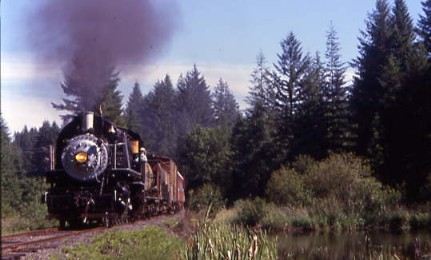
Joe Harper, the excellent videographer of trains and a good friend, had placed a post on Trainorders.com about a photo freight on the Chelatchie Prairie Railroad on June 30th, 2007. I had always wanted to ride this railroad so a check for $99 was sent in the mail and I received updates via e-mail from Joe as time progressed. I told Chris Parker about this so about a week beforehand, he decided to join me. Anton Lazzaro, who was spending his summer in Chemult, Oregon then also decided to do the trip and would take the Coast Starlight to Portland to join us. Chris chose a flight early that Friday morning and while he was in the air, I changed the reservation on the Dollar rental car reservation from my name to his so he could pick up the car. He would then pick me up at Portland Airport at 10:50 PM that night.
Alaska Airlines Flight 321 to Portland via Oakland 6/29/2007My mother drove me to the Orange County Airport and it took me fifteen minutes to get through security then I waited at Gate 13 while doing Sudoku puzzles and reading the Pacific Railroad Society's "Wheel Clicks". I boarded the 737-700 aircraft at 6:50 PM, taking Seat 21B. We took off at 7:23 PM and had a bumpy landing at Oakland at 8:26 PM. We took off from there into the nighttime sky at 9:19 PM and landed at Portland at 10:32 PM. I called Chris and found that neither he nor Anton were at the airport yet. Another call was made to let them know my exact location and I was picked up at 11:21 PM and we drove to the Days Inn on 82nd Street, received our rooms and called it a night.
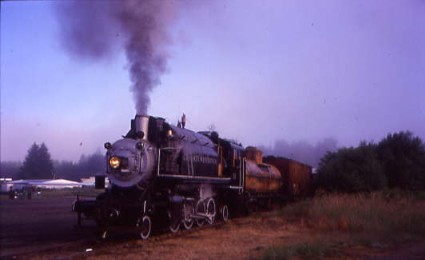
There had been ongoing discussion about the need for a railroad out of Vancouver for quite some time since the completion of the trans-continental railroad. The first person to take action was L.M. Hidden, a Vancouver businessman. Hidden was involved in farming, brick making, hotel operation and philanthropic endeavors. Hidden was also involved in Clark County activities and helped form the Clark County Fair Association.
There is an unverified story that Hidden and his family, along with several friends and their families, went on a picnic at Moulton Falls. They were so impressed with the abundant timber in the area that they decided to build a railroad to gain access to it. In any event, on 7/8/1886 Hidden and 5 associates left Vancouver to survey the proposed route to Yakima. Hidden felt that the route would give him access to the timber, the wheat growing country around Yakima and there might be coal and other minerals along the way. They were gone a month and returned with estimates of timber and mining resources and certain that a practical route could be laid out.
On 9/22/1887, the Clark County Register announced that the Vancouver, Klickitat and Yakima, Vancouver’s first railroad, had recently been incorporated with one million dollars in funding. L. M. Hidden was vice-president. On 1/31/1888, work began, and the first locomotive for the line arrived in Vancouver on 12/20/1888. The goal of the railroad was to serve Vancouver and Yakima by way of the Klickitat Pass. It was envisioned that it would ultimately connect with the Great Northern Railroad and the Manitoba line of the Canadian National Railway at Yakima creating a transcontinental connection.
The line was eventually built to Brush Prairie, but the country fell into an economic depression and money ran out for further expansion and operations. Finally, on 11/25/1897, the railroad was broke and had to be sold. It was renamed the Portland, Vancouver and Yakima Railroad by the new owners. Within four months under the new ownership, the railroad was bringing 50,000 board feet of logs a day from Brush Prairie to Vancouver. In November of 1898, the stockholders increased their capital stock from $50,000 to $250,000 and sought right of way to extend the line to Chelatchie Prairie.
By September 1901, there were 4 work camps working on extending the rail line to Yacolt. During that period, crews were working on a 300-foot long tunnel between the Lewis River and Battle Ground at Moulton Falls. The summer of 1902 was exceptionally dry and by the second week in September, there were fires all over the Northwest. One fire started near Bonneville, in Skamania County and moved through the timber covered hills taking 10 days to reach the Yacolt area. The wind changed and Yacolt was spared. By the time the fire burned out near Mt. St. Helens, the loss in property and resources reached approximately 13 million dollars. Much of the burned land was owned by the Weyerhaeuser Timber Company, which mounted a huge salvage operation, based in Yacolt. Operations were conducted by the Weyerhaeuser subsidiaries Clarke County Timber Company and Twin Falls Logging Company. The Twin Falls Logging Company laid track and ran logging trains through the woods.
In 1903, the railroad was completed to Yacolt, and the town boomed. Also that year, the P,V&K merged with the Washington and Oregon Railroad and they became the Washington Railway and Navigation Company. This company lasted only three-and-a-half-month and it was transferred to the Northern Pacific Railroad on 11/11/1903 to be under control of that company’s Pacific Division. The new owners immediately began regular passenger service to Yacolt, with one passenger coach making the trip each way daily. A one-way ticket from Yacolt to Vancouver cost $1.07. Prior to the addition of passenger coaches by the Northern Pacific, passengers rode wherever space was available; in the caboose, on freight cars, even on the engine.
The salvage of burned timber was completed by 1910, and by the mid-1920's, logging of green timber in the area was winding down. On December 4, 1929, George S. Long, general manager of Weyerhaeuser, wrote the stockholders of the Clarke County Timber Company regarding the closure of operations in the area. The area had been logged off, he wrote, and that there was no demand for the land for agricultural purposes as it would cost more for the purchaser to clear the land of stumps than he could buy an already cleared and cultivated parcel for.
After the departure of Weyerhaeuser, the Northern Pacific continued to operate logging trains on the line to serve the remaining small-scale operations in the area, but there was no longer any need for passenger service. By the mid-1940's, the Northern Pacific was only running one train a week to Yacolt. In 1948, Harbor Plywood completed the long planned extension to Chelatchie Prairie, opening that area to logging. Two years later, the Longview, Portland and Northern bought the rail line Harbor Plywood and later bought the remainder of the line from the Northern Pacific. International Paper Company, the parent company of the L,P&N, built a huge lumber and plywood plant there in 1960.
Even though the Northern Pacific sold the line, it was not the end of NP involvement in the area. In the late 1950's, NP was running one log train a day from Kelso to Yacolt. The train would leave Kelso at 7:00 am, pick up empty cars at Longview, stop at Battle Ground where the crew would eat lunch, and arrive at Yacolt at 12:3 0pm. On the return trip, the train would drop off the log cars at Longview and be back in Kelso at 7:45 pm. When the mill was closed in 1979, the entire line was put up for sale.
Three Vancouver businessmen bought the line in March 1981 and changed its name to the Chelatchie Prairie Railroad. It was used both commercially and for passenger traffic until January of 1984 when the owners filed for abandonment in order to tear it up, sell the tracks and ties and 340 acres of right-of-way. Clark County purchased the railroad and leased it to the Lewis and Clark Railroad, which had run excursion service and continues to use a portion of the line for commercial purposes.
Over time, with severe winter weather, lack of maintenance and changes in ownership, the track-bed, rails, bridges, and buildings north of Battle Ground have deteriorated. A group of community volunteers came together in 1998 with the goal of restoring the line and building the Chelatchie Prairie Railroad into a functioning historical railroad. Working with the support of Clark County, the track from Moulton Falls to Chelatchie Prairie has been restored, and excursion service resumed on May 26, 2001. Work continues on improving the track and upgrading equipment with the goal of restoring service to Battle Ground.
Chelatchie Prairie Photo Freight 6/30/2007Our train taking water before starting our day of fun. The consist of our photo freight was Crossett Western 2-8-2T 10, water car 577, ex Southern Georgia later Longview, Portland and Northern Northern Pacific box car 207778, BYCX 555 hopper car, BYCX twelve-berth sleeper 60 "Glen Shan" and BYCX caboose 10559.
Battle Ground, Yacolt and Chelatchie Railroad 2-8-2T 10, ex. Peter Replinger 1974, exx. donation to City of Fortuna, California, exxx. Georgia Pacific Corporation 16 1956, exxxx. Hammond Lumber Company 16, nee Crossett Western Company 10 built by American Locomotive Company in 1929.
Battle Ground, Yacolt and Chelatchie Railroad S-2 1, ex. Relco 1029, exx. Chrome Crankshaft 1 1975, nee Los Angeles Junction Railway 1 built by American Locomotive Company in 1941.
The two engines which will come into play today. I checked in and signed my release for the trip before purchasing the DVD "Chasing the Portland Rose Tour and the Puget Sound Steam Special" featuring steam engines Union Pacific 844 and Southern Pacific 4449 that Joe Harper had filmed, covering over 1,400 trackside miles. I had some maple bars and bought a T-shirt form the Chelatchie Prairie Railroad gift shop. At 7:50 AM, we had a group meeting about the trip, safety and other items people needed to know. Joe introduced me to the group as having completed a million rail miles. We all then walked in front of the station to set up for our first photo runby of the day.
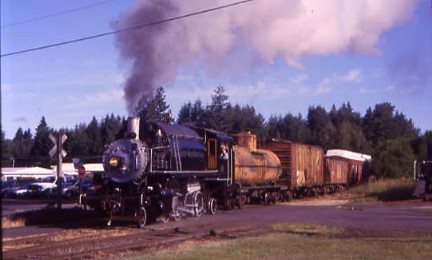
The train came across the main road in Yacolt and we then relocated to a new location for the next runby.
The reverse move passed the Yacolt station.
The Yacolt station.
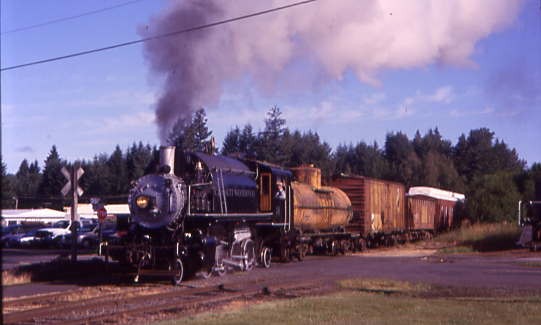
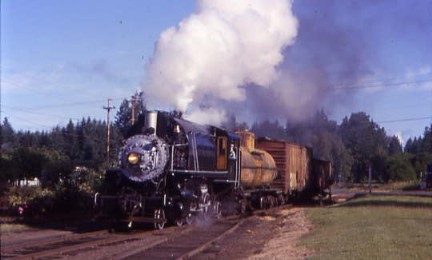
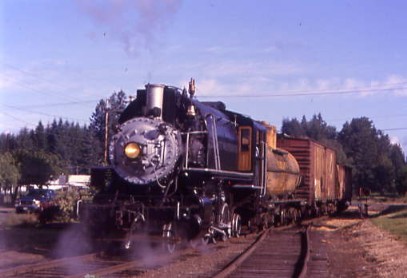
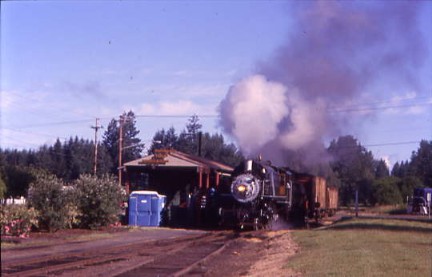
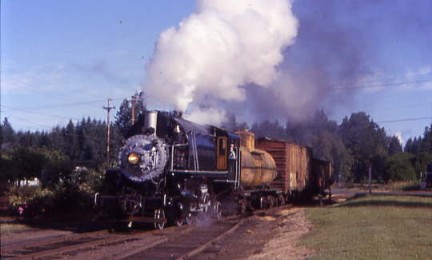
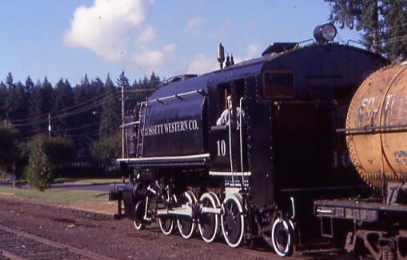
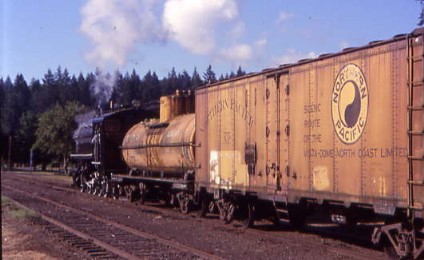
Photo runby two.
The reverse move to position our train for loading. We all boarded the train with the three of us taking up one side of the cupola in the caboose.
A look back at the station as we departed.
Railroad Avenue and the forest. The train took us down the rails to where the crew thought the runby location was.
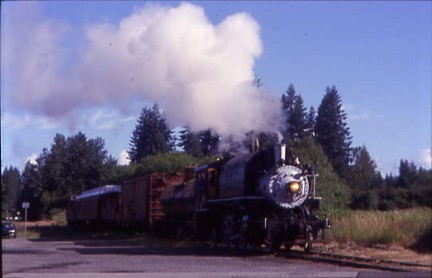
The reverse move.
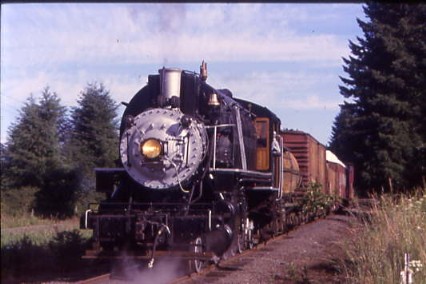
We detrained to discover it was the wrong location but bonus runby three was performed here, after which everyone reboarded and the train then reversed to the real location.
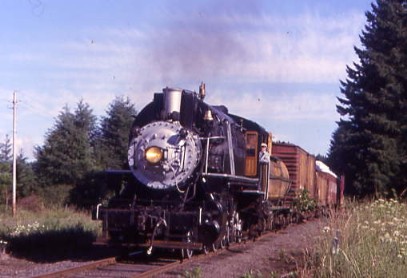
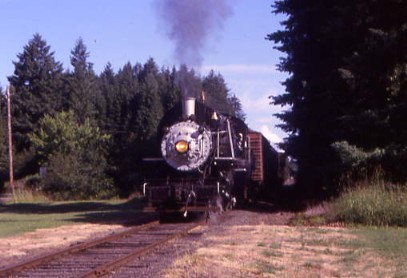
The reverse move.
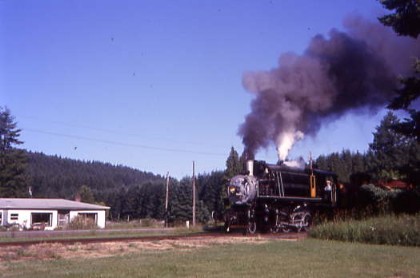
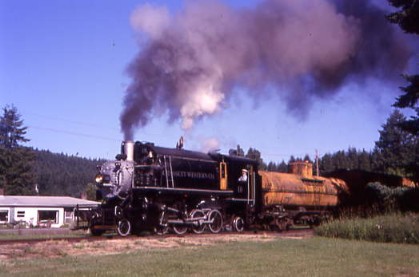
Photo runby four, after which we continued south to the Yacolt Creek trestle.
The reverse move.
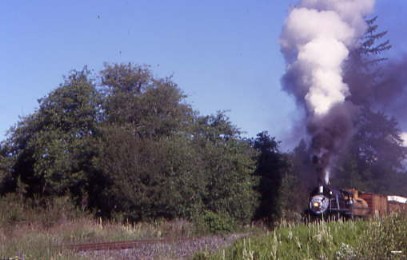
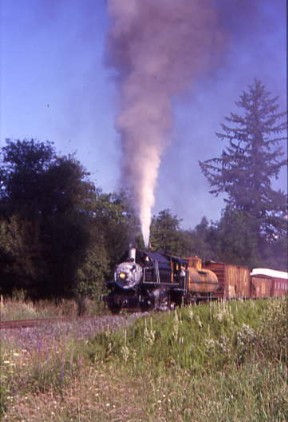
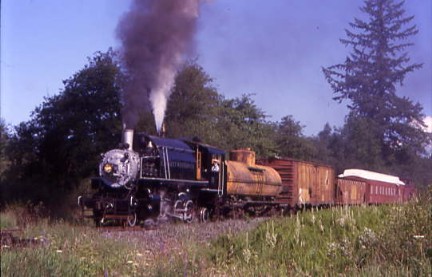
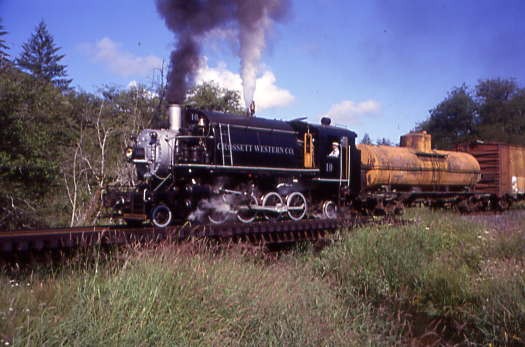
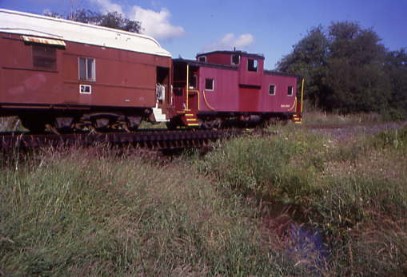
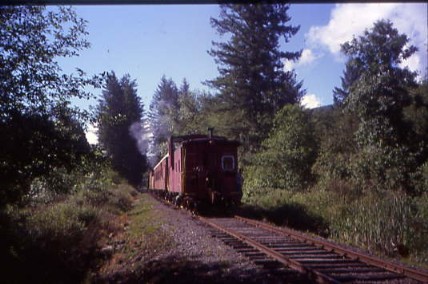
Photo runby five at the trestle. We all reboarded and proceeded to the next location of the only tunnel on this railroad.
About to exit the 330 foot tunnel. Once clear, we stopped to unload the train for a static shot.
Reversing into position.
The static shot at the south portal of the tunnel.
The East Fork of the Lewis River far below us at this point. We reboarded once more and crossed the bridge across the Lewis River to the next location. Once we arrived here, the lighting was all wrong but it was decided to proceed with the runby then take the train back to Yacolt to wye the engine and rearrange the cars so that the engine would be on the north end of the train for the rest of the day.
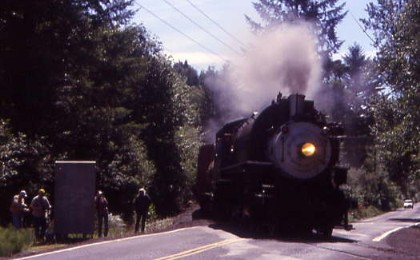
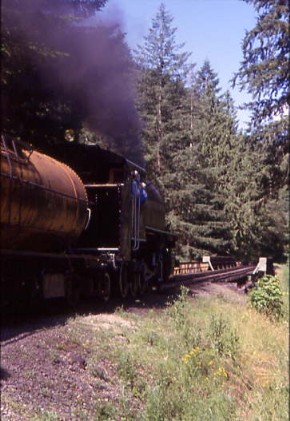
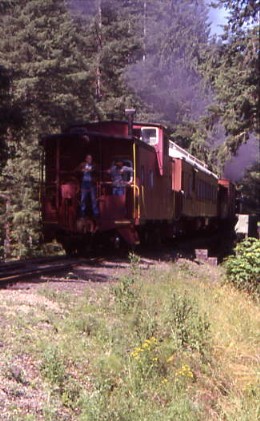
Photo runby six. I decided to try to see just high this bridge was so walked down the highway then cut through the trees but the train reversed before I could get through the trees and vines.
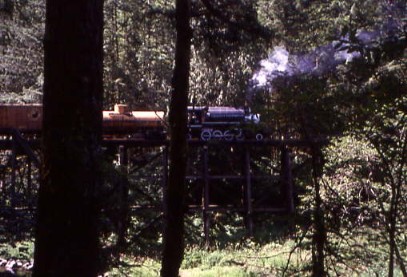
We all returned to the train for the journey to Yacolt.
Entering the south portal of the 330 foot tunnel.
Exiting the north portal.
Coming out of the deep cut that leads to the tunnel.
Another view as we reversed towards Yacolt, where we were given the option of staying on the train, which I did. The steam engine cut off to be watered and the S3 started to rearrange our trainset.
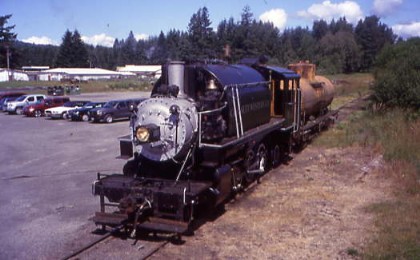
Our steam engine at rest.
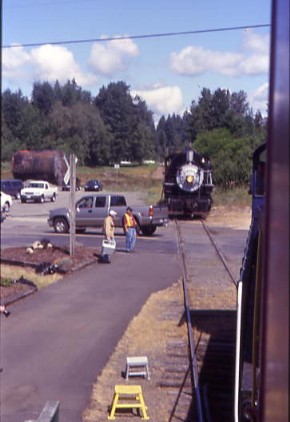
We were now spotting the freight cars on the station siding.
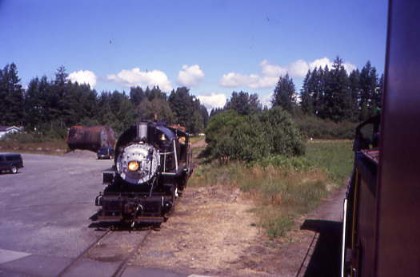
Passing the station, I called Let's Talk Trains, the Internet Radio Show, and gave a very interesting report about this photo freight.
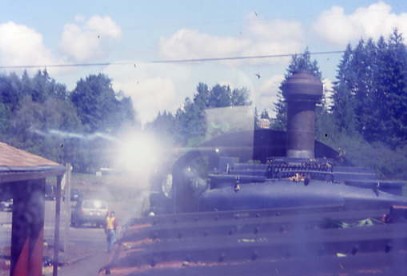
The headlight of the Alco coming towards us.
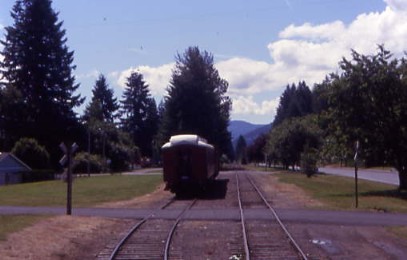
The rest of the train had been spotted and now we would be taken back to the mainline to be the last car on the train.
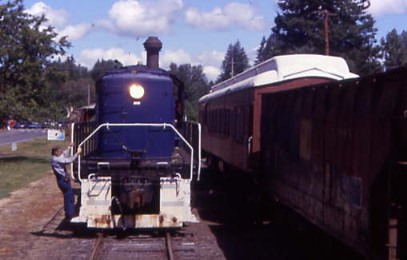
The S3 then cut off the caboose before it put back together the rest of our train. The steam engine was coupled up and we returned south to the East Fork of the Lewis River bridge for the next photo runbys.
The north portal of the tunnel.
About to exit the south portal.
Passing a rock outcropping, after which we arrived at the bridge.
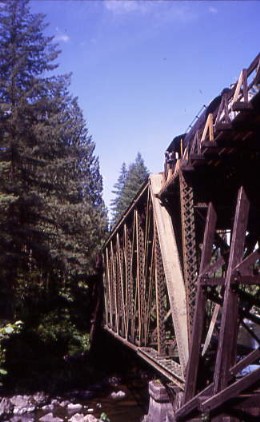
The East Fork of the Lewis River bridge.
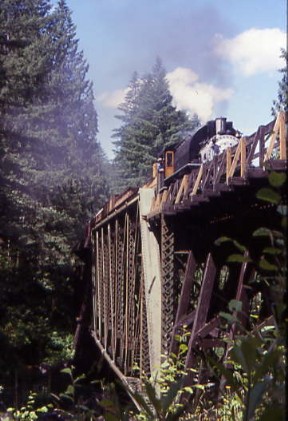
Photo runby seven from below the bridge. I relocated to the grade crossing.
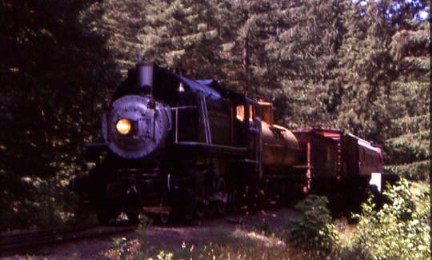
The reverse move.
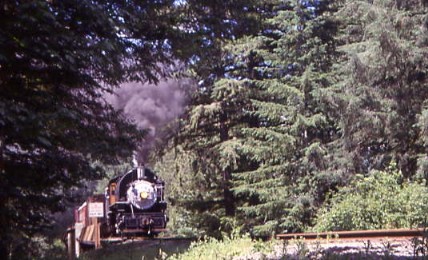
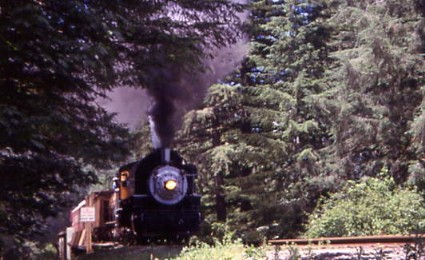
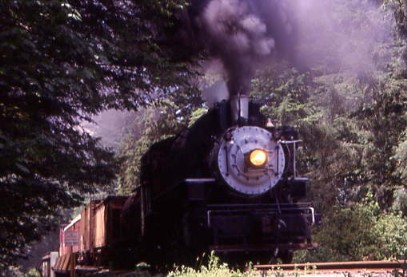
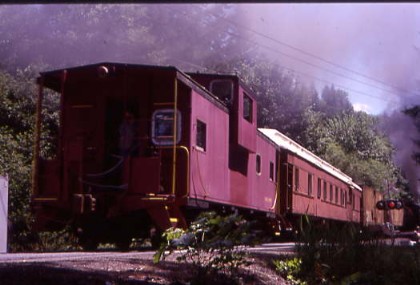
We reboarded our train and returned to the south portal.
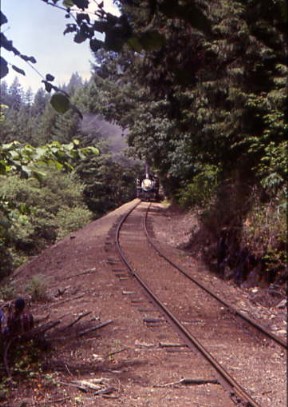
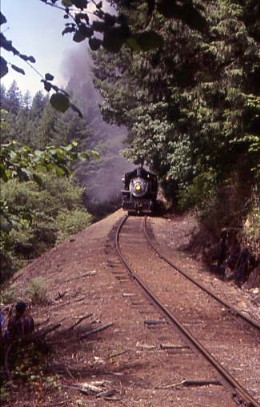
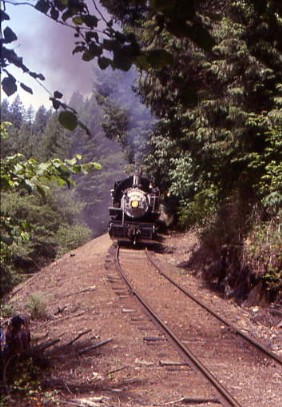
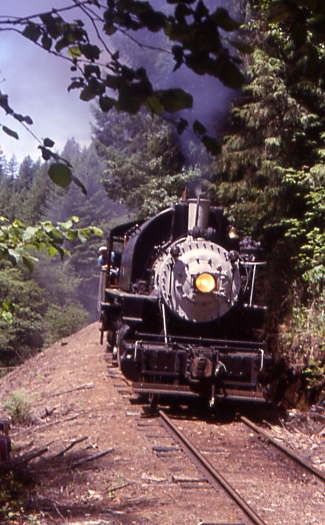
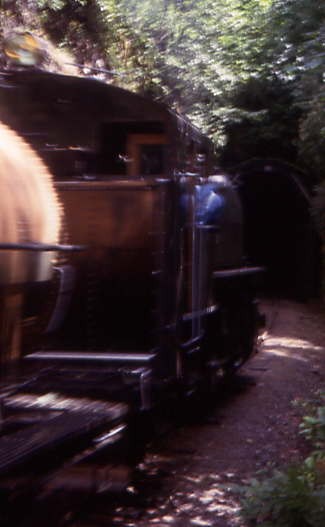
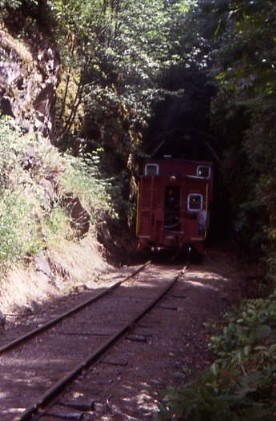
Photo runby eight.
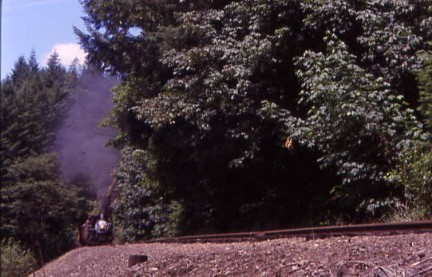
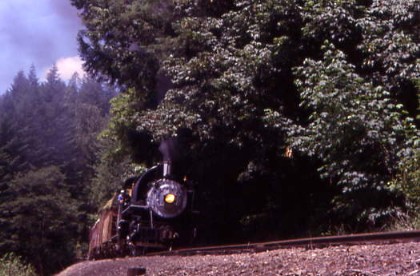
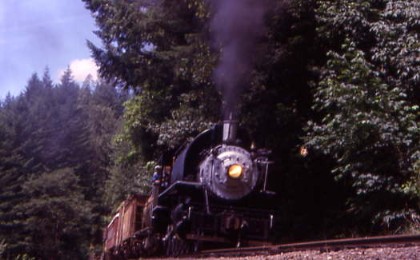
Photo runby nine looking from below. We all then reboarded and the train took us back to Yacolt for lunch. The Red Fir Restaurant was a bar where the under-21 crowd could not eat. Chris and I decided to join Anton and our new friends for an excellent pork and chicken lunch outside on a beautiful day.
Enjoying lunch.
The whole group of us after a cell phone ring tone story was shared and a good laugh was had by all. After that I walked back to the train.